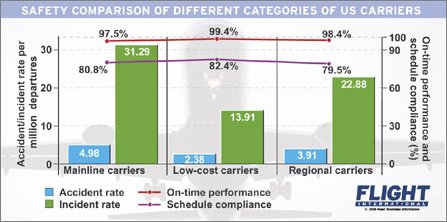Study highlights superior strategy and organisation
US low-cost carriers (LCC) demonstrate better safety performance than their mainline or regional airline counterparts, says a study by San Jose State University, California. The results are not an aberration, the study notes, but a result of superior “strategic choices and organisational cultures”.
|
The period under study is 1 January 2000-31 December 2004, but it excludes the 9/11 events, Flores told last week’s Flight Safety Foundation/European Regions Airline Association European Aviation Safety Seminar in Athens, Greece.
Airlines studied were the top five US mainline scheduled carriers by number of departures, the top four LCCs and the top four regionals.
The mainline carriers have an accident rate (as defined by the US Federal Aviation Administration) of 4.98 per million departures, the LCCs 2.38 and the regionals 3.91 (see chart). Because one of the LCCs has had no accidents, the study includes incident rates and these, respectively, are 31.29, 13.91 and 22.88 per million departures.
Only the top two LCCs designated as such by the FAA are considered by Flores to comply with what is now accepted as the classic no-frills LCC model, but if those alone were compared, the performance disparity in their favour would have been even more dramatic, Flores says.
He concludes that strategic choices and organisational cultures were key to performance, citing the LCCs’ choice of single-type fleets of third-generation jets, and “simpler organisational structures”.
DAVID LEARMOUNT / ATHENS
Source: Flight International




















